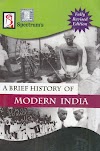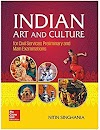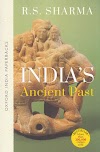Later Mughals
After the death of Aurengzeb in 1707, war of succession started among his sons in which prince Muazzam defeated and killed his brothers Azam Khan and Kambaksh. He ascended to the throne with the title of 'Bahadur Shah'.
Bahadur Shah (1707-12)
- He reversed the narrow minded policies of Aurengzeb and adopted tolerant attitude towards Hindus. For example - No Hindu temple was destroyed during his tenure.
- He released Maratha prince Shahu from the Mughal captivity who was captive since 1689.
- He also made peace with Rajputs, Jats and Bundelas. He also offered very high mansab to Guru Govind Singh but after the death of Guru Govind Singh, Sikh people revolted under the leadership of Banda Bahadur.
- Bahadur Shah was often termed as 'Shah-i-Bekhabar' (headless king) because he was lavishly granted jagirs and promotions.
- After his death his sons were in such indecent haste of grabbing power that they left Bahadur Shah's body unburied for about a month.
Jahandar Shah (1712-13)
- He came to power due to the support of most powerful noble of that time Zulfiquar Khan.
- Jahandar Shah was a degenerated person fully indulge in pleasure as such administration was fully in the hands of Zulfiquar Khan.
- He abolished Jizya tax (it's a type of security tax paid by non-muslims)
- He started Izara system or Revenue farming to improve the finances. Under this system tax collection authority was given by bidding process. The highest bidder was given the contract who was known as Izaradar. He was free to extract whatever he could from the peasant leading to the increased oppressions on the peasantry.
- He granted the rights of Chauth and Sardeshmukhi of Deccan to Marathas. Chauth is One-forth of the revenue assessment and Sardeshmukhi is 10% additional levy. In turn Maratha promised to maintain a contingent of 15000 soldiers in the service and protection of Mughal emperor.
Farrukhsiyar (1713-1719)
- He came to power with the support of Sayyid Brothers, Abdullah Khan and Hasan Ali. As such a token of gratitude Abdullah was appointed wazir and Hasan Ali as Mir Bakshi.
- Farrukhsiyar was incapable and influenced by flatterers. Taking advantage of this Sayyid brothers took full control of administration.
- They adopted the policy of religious tolerance and associated Hindu chiefs and nobles in governance.
- They also abolished Pilgrimage tax.
- During their tenure Sikh leader Banda Bahadur was taken as prisoner from Gurudaspur and executed at Delhi.
- Royal Farman of 1717 - One British physician William Hamilton cured Farrukhsiyar who was suffering from a disease. As a token of gratitude he gave Royal Farman to the company.
- Provisions of the Farman - The company was permitted to carry on trade in Bengal, Bombay and Madras free of custom duty; The company was also permitted to mint its own coin and further fortify Calcutta; The company servants were also permitted to carry out private trade but they were required to pay the same tax as Indian merchants. (it was the most misused provision by the company servant)
- When Farrukhsiyar was conspiring to get rid of Sayyid Brothers, they proved to be very clever for him and with the help of Peshwa Balaji Vishwanath, they dethroned the emperor, blinded him and kill him.
- After Farrukhsiyar, Sayyid borthers made Rafi-ud-Darjat the emperor, then Rafi-ud-Daula. Both ruled for few months and died.
Muhammad Shah (1719-1748)
- A powerful group of nobles headed by Chin Qilich Khan or Asaf Jah were weary of the growing power of Sayyid Brothers. Muhammad Shah also wanted to get rid of Sayyid Brothers as such with the help from Asaf Jah Muhammad Shah succeeded in killing them.
- It was a chance to save the Mughal empire but Muhammad Shah was not the man of the moment. He was weak minded and frivolous and often referred as 'Rangeela' since he was always indulge in wine and women.
- During his tenure, an irreversible decline of Mughal empire initiated and it started to break up.
- Powerful nobles started to carve out semi-independent and autonomous state for themselves.
- Bengal - Murshid Qulli Khan (1717)
- Awadh - Saadat Khan (1722)
- Hyderabad - Nizam-ul-mulk Asaf Jah (chin Qilich Khan)
- In 1739, Nadir Shah of Persia defeated Mughals in the Battle of Karnal. To avenge killing of handful of his soldiers he did a terrible massacre in the imperial city of Delhi. He also looted the famous Peacock Throne of Shah Jahan and the Kohinoor Diamond.
- After the death of Nadir Shah, his successor Ahmed Shah Abdali invaded and plundered Mughal empire seven times between 1747 to 1767.
Ahmed Shah (1748-54)
- During his tenure, Abdali invaded twice in 1749 and 1752. As such Mughal emperor surrendered Multan and Punjab to Abdali.
Alamgir II (1754-1759)
- During his tenure Maratha invaded Delhi to drive out Afghans and Rohillas. Marathas occupied Lahore and Punjab.
- Battle of Plassey was fought in his reign.
Shah Jahan II (1759-1760)
Shah Alam II (1760-1806)
- He came to power with the support of Maratha Sardar Sada Shiv Rao Bhau.
- He was the man of some ability and courage but the Mughal empire was now beyond redemption.
- His reign witness two important battle, i.e., Third battle of Panipath (1761) and Battle of Buxar (1764).
- When Abdali was leaving Delhi, he exiled Mughal emperor Shah Alam from Delhi to Allahadab. Meanwhile, power in Delhi was exercised by Rohilla leader, Zabita Khan and Najibullah Khan.
- In 1771, Maratha sardar Mahad Ji Sindhia invaded Delhi, repelled Rohillas and reinstated Mughal emperor to the throne.
- Later in 1788, Shah Alam was blinded by Rohilla leader Zabita Khan but soon Mahad Ji Scindia hunted down Rohilla leader and restored the position of Shah Alam II.
Akbar II (1806-1837)
- He gave the title of 'Raja' to famous social reformer Rammohan Roy.
- In 1835, English East India Company stopped minting coins in the name of Mughal emperor.
Bahadur Shah II/Bahadur Shah Zafar (1837-1857)
- During his tenure, mighty Revolt of 1857 happened.
- In legal terms, Mughal rule came to an end on November 01, 1858 with the declaration of queen Victoria.
Previous Article - Advent of Europeans
Next Article - Decline of Mughals
Notes on other subjects
Optional Notes
Note - This is my Vision IAS Notes (Vision IAS Class Notes) and Ashutosh Pandey Sir's Public Administration Class notes. I've also added some of the information on my own.
Hope! It will help you to achieve your dream of getting selected in Civil Services Examination 👍





0 Comments